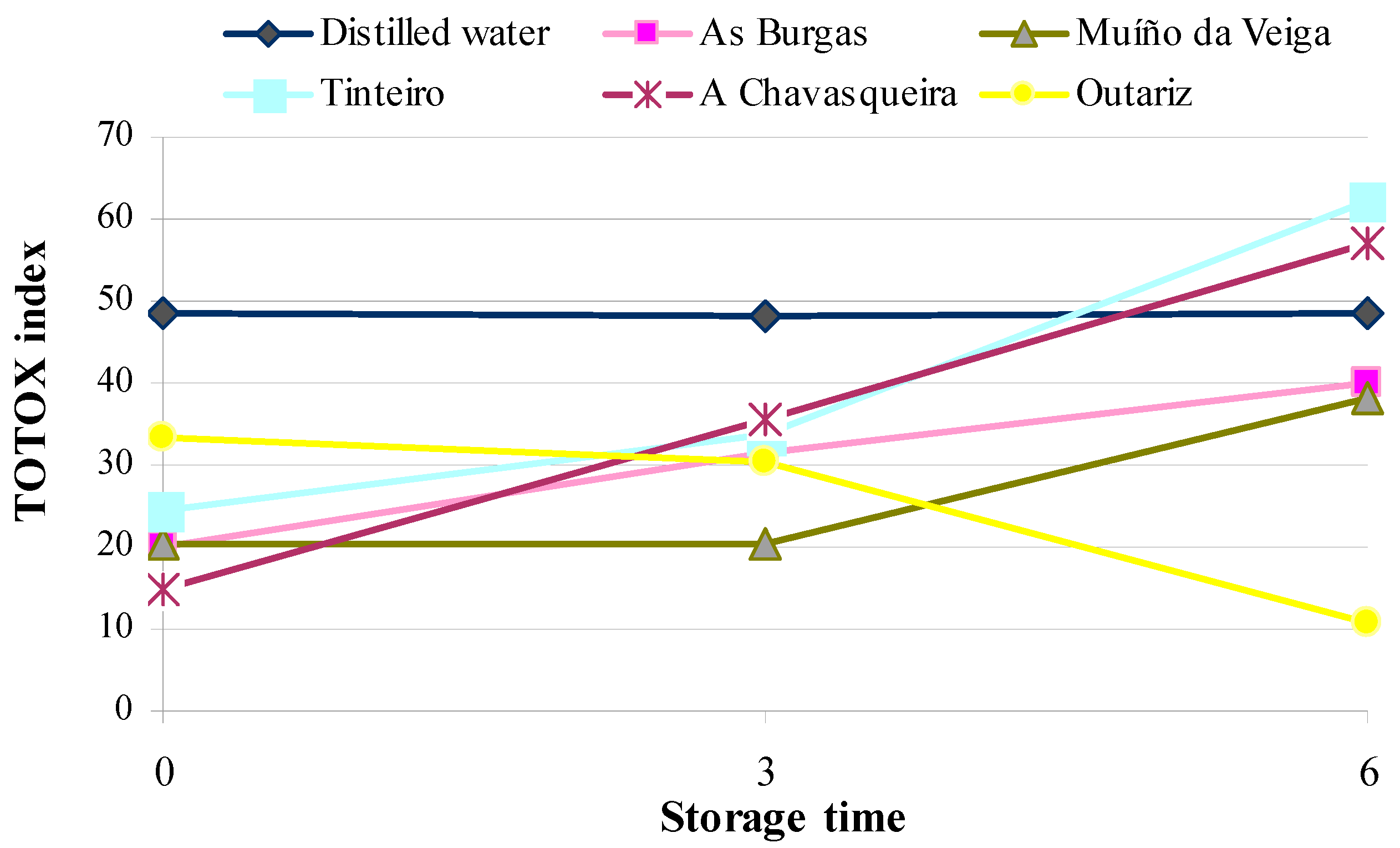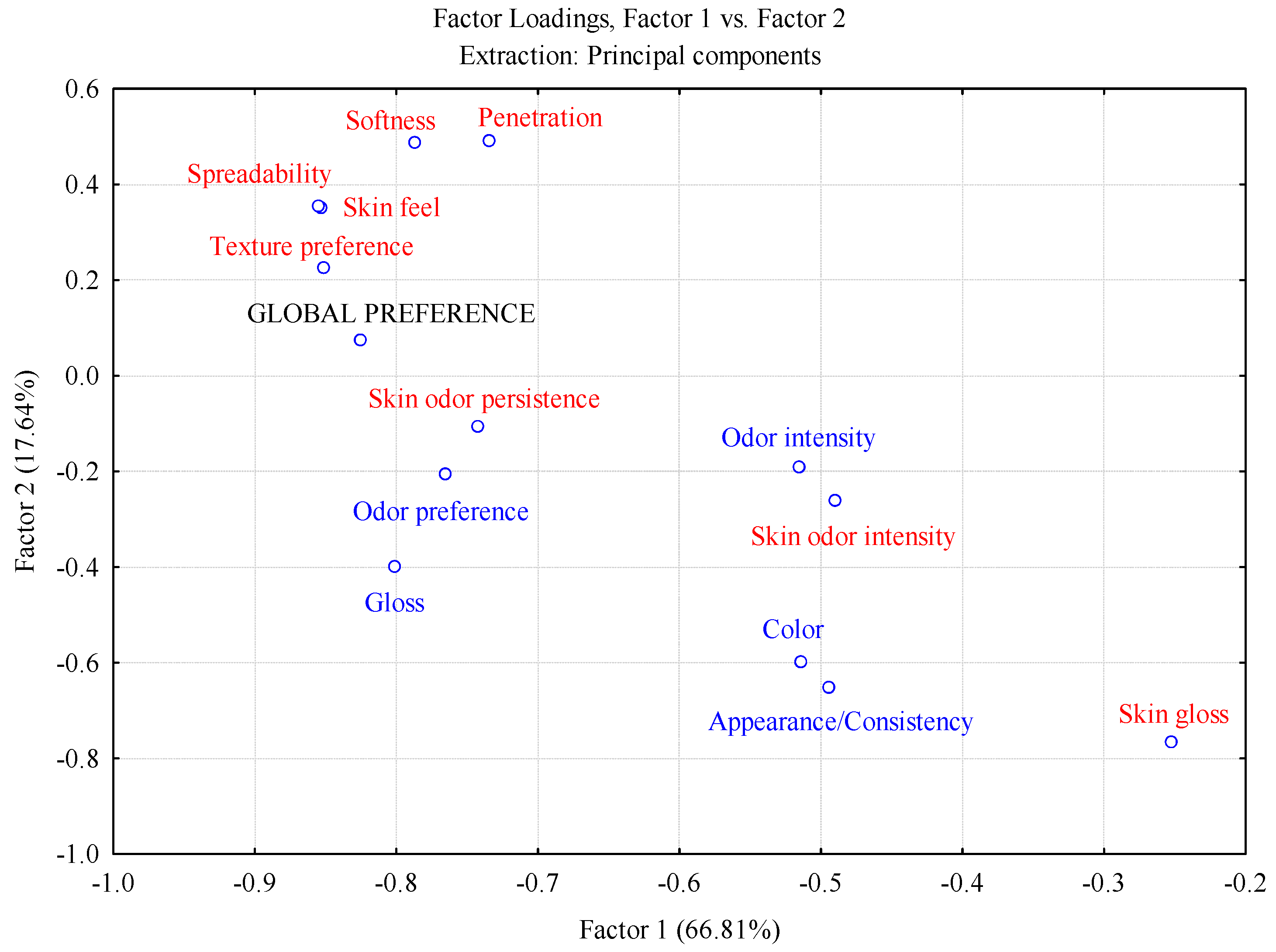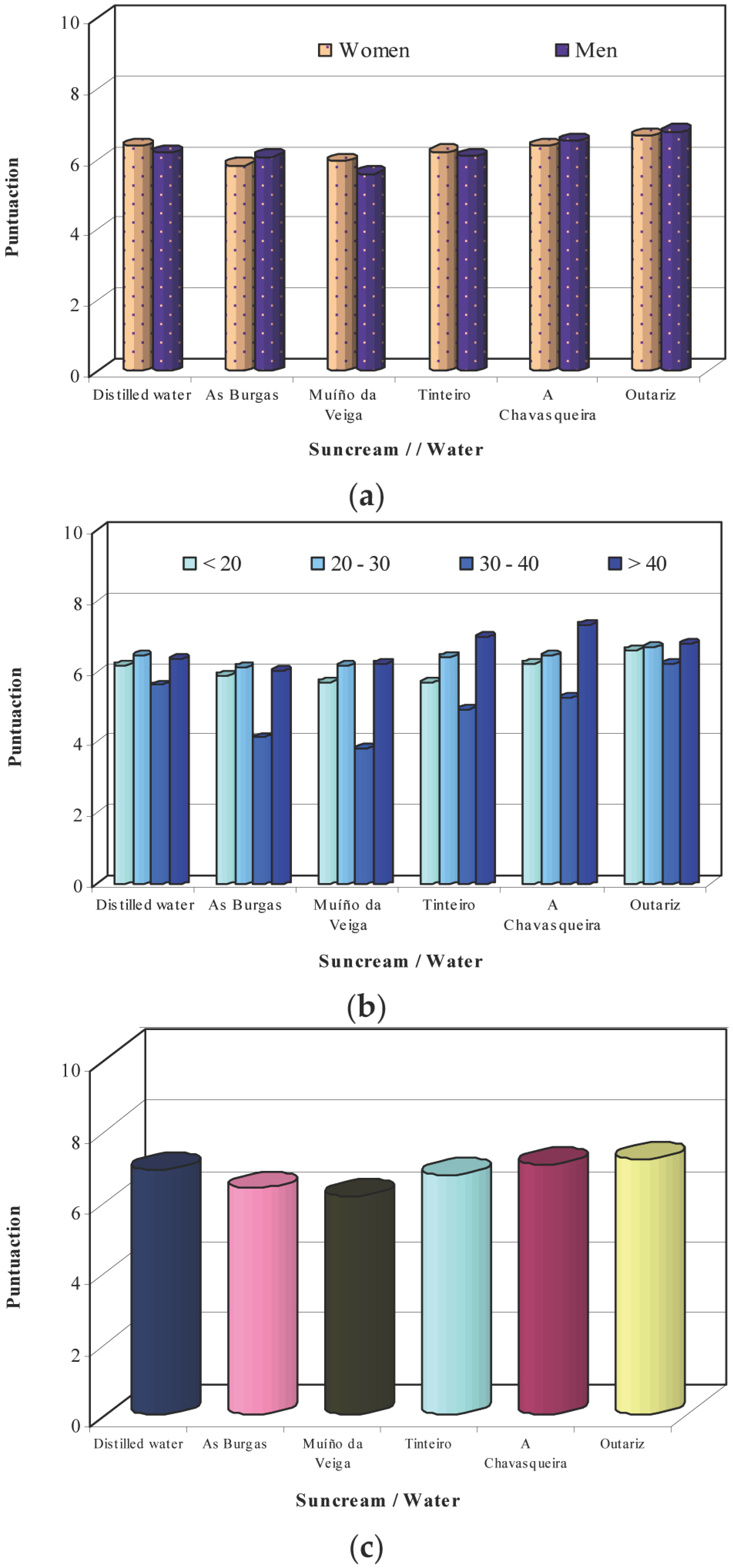Stability of Sun Creams Formulated with Thermal Spring Waters from Ourense, Northwest Spain
Abstract
:1. Introduction
2. Materials and Methods
2.1. Origin of the Waters
2.2. Sun Cream Preparation
2.3. Microbiological Control
2.4. Physico-Chemical Control
2.4.1. pH
2.4.2. Oxidation
2.4.3. Color
2.5. Sensory Analysis
2.6. Statistical Analysis
3. Results and Discussion
3.1. Microbiological Control
3.1.1. Thermal Spring Waters
3.1.2. Sun Creams
3.2. Physico-Chemical Control
3.2.1. pH
3.2.2. Oxidative Stability
3.2.3. Color
3.3. Sensory Analysis
4. Conclusions
Acknowledgments
Author Contributions
Conflicts of Interest
References
- Yanishlieva, N.V.; Marinova, E.M. Stabilisation of edible oils with natural antioxidants. Eur. J. Lipid Sci. Technol. 2001, 103, 752–767. [Google Scholar] [CrossRef]
- Yanishlieva, N.V.; Marinova, E.; Pokorný, J. Natural antioxidants from herbs and spices. Eur. J. Lipid Sci. Technol. 2006, 108, 776–793. [Google Scholar] [CrossRef]
- European Commission Directive 2010/67/EC. Directive 2008/84/EC Laying down Specific Purity Criteria on Food Additives Other than Colours and Sweeteners. Available online: http://eur-lex.europa.eu/legal-content/EN/TXT/?uri=CELEX%3A32010L0067 (accessed on 14 December 2016).
- European Commission Directive 2010/69/EC. Annexes of Directive 95/2/EC on Food Additives Other than Colours and Sweeteners. Available online: https://publications.europa.eu/en/publication-detail/-/publication/856f3f44-c877-43d2-b73f-32d280b5f9fb/language-en (accessed on 14 December 2016).
- Birtić, S.; Dussort, P.; Pierre, F.X.; Bily, A.C.; Roller, M. Carnosic acid. Phytochemistry 2015, 115, 9–19. [Google Scholar] [CrossRef] [PubMed]
- Ribeiro-Santos, R.; Carvalho-Costa, D.; Cavaleiro, C.; Costa, H.S.; Albuquerque, T.G.; Castilho, M.C.; Ramos, F.; Melo, N.R.; Sanches-Silva, A. A novel insight on an ancient aromatic plant: The rosemary (Rosmarinus officinalis L.). Trends Food Sci. Technol. 2015, 45, 355–368. [Google Scholar] [CrossRef]
- Ayşegül Koluman, N.M.; Süzgeç-Selçuk, S. Pyhtocosmetics in pharmacy. Marmara Pharm. J. 2016, 20, 7–20. [Google Scholar]
- Al-Sereiti, M.R.; Abu-Amer, K.M.; Sen, P. Pharmacology of rosemary (Rosmarinus officinalis Linn.) and its therapeutic potentials. Indian J. Exp. Biol. 1999, 37, 124–130. [Google Scholar] [PubMed]
- Baumann, L.S. Less-known botanical cosmeceuticals. Dermatol. Ther. 2007, 20, 330–342. [Google Scholar] [CrossRef] [PubMed]
- Pérez-Fons, L.; Aranda, F.J.; Guillén, J.; Villalaín, J.; Micol, V. Rosemary (Rosmarinus officinalis) diterpenes affect lipid polymorphism and fluidity in phospholipid membranes. Arch. Biochem. Biophys. 2006, 453, 224–236. [Google Scholar] [CrossRef] [PubMed]
- Packer, J.F.; Da Luz, M.M.S. Evaluation and research method for natural products inhibitory activity. Braz. J. Pharmacogn. 2007, 17, 102–107. [Google Scholar] [CrossRef]
- Muyima, N.Y.O.; Zulu, G.; Bhengu, T.; Popplewell, D. The potential application of some novel essential oils as natural cosmetic preservatives in a aqueous cream formulation. Flavour Fragr. J. 2002, 17, 258–266. [Google Scholar] [CrossRef]
- Santoro, M.I.; Da Costa, E.; Oliveira, D.A.; Kedor-Hackmann, E.R.; Singh, A.K. The effect of packaging materials on the stability of sunscreen emulsions. Int. J. Pharm. 2005, 297, 197–203. [Google Scholar] [CrossRef] [PubMed]
- Nohynek, G.J.; Antignac, E.; Re, T.; Toutain, H. Safety assessment of personal care products/cosmetics and their ingredients. Toxicol. Appl. Pharmacol. 2010, 243, 239–259. [Google Scholar] [CrossRef] [PubMed]
- Mukherjee, P.K.; Maity, N.; Nema, N.K.; Sarkar, B.K. Bioactive compounds from natural resources against skin aging. Phytomedicine 2011, 19, 64–73. [Google Scholar] [CrossRef] [PubMed]
- Kusumawati, I.; Indrayanto, G. Natural antioxidants in cosmetics. Stud. Nat. Prod. Chem. 2013, 40, 485–505. [Google Scholar]
- Tundis, R.; Loizzo, M.R.; Bonesi, M.; Menichini, F. Potential role of natural compounds against skin aging. Curr. Med. Chem. 2015, 22, 1515–1538. [Google Scholar] [CrossRef] [PubMed]
- Carubbi, C.; Gobbi, G.; Bucci, G.; Gesi, M.; Vitale, M.; Mirandola, P. Skin, inflammation and sulfurous waters: What is known, what is believed. Eur. J. Inflamm. 2013, 11, 591–599. [Google Scholar]
- Costantino, M.; Giampaolo, C.; Filippelli, A. Effects of drinking SPA therapy on oxidative stress. Clin. Ther. 2013, 163, e13–e17. [Google Scholar]
- Nunes, S.; Tamura, B.M. Biochemical and toxicological assessment of a Brazilian mineral water and its effects on the skin. Surg. Cosmet. Dermatol. 2011, 3, 197–202. [Google Scholar]
- Elkhyat, A.; Courderot-Masuyer, C.; Mac-Mary, S.; Courau, S.; Gharbi, T.; Humbert, P. Assessment of spray application of Saint GERVAIS® water effects on skin wettability by contact angle measurement comparison with bidistilled water. Skin Res. Technol. 2004, 10, 283–286. [Google Scholar] [CrossRef] [PubMed]
- Merial-Kieny, C.; Castex-Rizzi, N.; Selas, B.; Mery, S.; Guerrero, D. Avène thermal spring water: An active component with specific properties. J. Eur. Acad. Dermatol. Venereol. 2011, 25, 2–5. [Google Scholar] [CrossRef] [PubMed]
- Delgado-Outeiriño, I.; Araujo-Nespereira, P.; Cid-Fernández, J.A.; Mejuto, J.C.; Martínez-Carballo, E.; Simal-Gándara, J. Behaviour of thermal waters through granite rocks based on residence time and inorganic pattern. J. Hydrol. 2009, 373, 329–336. [Google Scholar] [CrossRef]
- European Regulation (EC) 1223/2009, on 30 November 2009, on Cosmetic Products. Available online: http://ec.europa.eu/health//sites/health/files/endocrine_disruptors/docs/cosmetic_1223_2009_regulation_en.pdf (accessed on 14 December 2016).
- UNE-EN ISO 22716/2008. Cosmetics—Good Manufacturing Practices (GMP). Guidelines on Good Manufacturing Practices. Available online: http://www.aenor.es/aenor/normas/normas/fichanorma.asp?tipo=N&codigo=N0041130#.WE6MP-bhCUk (accessed on 14 December 2016).
- Fonseca, A.P.; Rafaela, N. Determination of sun protection factor by UV-Vis spectrophotometry. Health Care Curr. Rev. 2013, 1, 1–4. [Google Scholar]
- Balboa, E.; Soto, M.L.; Nogueira, D.; González-López, N.; Conde, E.; Moure, A.; Vinardell, M.P.; Mitjans, M.; Domínguez, H. Potential of antioxidant extracts produced by aqueous processing of renewable resources for the formulation of cosmetics. Ind. Crops Prod. 2014, 58, 104–110. [Google Scholar] [CrossRef] [Green Version]
- Real Decreto 140/2003. De 7 de Febrero, por el que se Establecen los Criterios Sanitarios de Calidad del Agua de Consumo Humano. Available online: https:// www.boe.es/buscar/act.php?id=BOE-A-2003-3596 (accessed on 14 December 2016).
- UNE-EN ISO 18415/2012. Cosmetics. Microbiology. Detection of Specific and Non-Specific Microorganisms. Available online: http://www.aenor.es/aenor/normas/normas/fichanorma.asp?tipo=N&codigo=N0048756#.WE6QzObhCUk (accessed on 14 December 2016).
- Díaz, M.; Dunn, C.M.; McClements, D.J.; Decker, E.A. Use of caseinophosphopeptides as natural antioxidants in oil-in-water emulsions. J. Agric. Food Chem. 2003, 51, 2365–2370. [Google Scholar] [CrossRef] [PubMed]
- AOAC (Association of Official Analytical Chemists). International Official Method of Analysis, Cd 18–90. p-Anisidine Value; AOAC: Gaithersbrug, MD, USA, 1997. [Google Scholar]
- Wang, Z.; Hwang, S.H.; Lim, S.S. Lipophilization of phenolic acids with phytosterols by chemoenzymatic method to improve their antioxidant activities. Eur. J. Lipid Sci. Technol. 2015, 117, 1–12. [Google Scholar] [CrossRef]
- Isaac, V.; Chiari, B.G.; Magnani, C.; Corrêa, M.A. Análise sensorial como ferramenta útil no desenvolvimento de cosméticos. Rev. Ciênc. Farm. Básica Apl. 2012, 33, 479–488. (In Portuguese) [Google Scholar]
- Ourense Thermal. Available online: http://termalismo.ourense.es/en/ (accessed on 27 July 2016).
- Gallego, M.G.; Gordon, M.H.; Segovia, F.J.; Skowyra, M.; Almajano, M.P. Antioxidant properties of three aromatic herbs (rosemary, thyme and lavender) in oil-in-water emulsions. J. Am. Oil Chem. Soc. 2013, 90, 1559–1568. [Google Scholar] [CrossRef]
- Rodríguez, L.A. Microbiología de las aguas. In Ourense Termal; Deputación de Ourense: Ourense, Spain, 2001; pp. 23–30. (In Spanish) [Google Scholar]
- Eau Thermale Avéne. Available online: http://www.eau-thermale-avene.fr/bebe/soins-de-bebe/creme-hydratante-cosmetique-sterile (accessed on 27 July 2016).
- Mosso, M.A.; Sánchez, M.C.; Rodríguez, C.; de la Rosa, M.C. Microbiología de los manantiales mineromedicinales del Balneario Cervantes. Anal. Real Acad. Nac. Farm. 2006, 72, 285–304. [Google Scholar]
- De la Rosa, M.C.; Mosso, M.C. Diversidad microbiana de las aguas minerales termales. In Panorama Actual de las Aguas Minerales y Minero-Medicinales en España; Instituto Geológico Minero Español (IGME): Madrid, Spain, 2000; pp. 153–158. [Google Scholar]
- De La Rosa, M.C.; Pintado, C.; Rodríguez, C.; Mosso, M.A. Estudio IV: Análisis microbiológico de las aguas. In Balnearios de España Aguas Minerales y mineromedicinales Monografía XXXII El Raposo; Real Academia Nacional de Farmacia: Madrid, Spain, 2013; pp. 65–85. [Google Scholar]
- Denis, A. What are the laboratories purposes for the development of a sunscreen for children? Nouv. Dermatol. 2001, 20, 303–305. [Google Scholar]
- Kunicka-Styczynska, A.; Smigielski, K.; Prusinowska, R.; Rajkowskal, K.; Kusmider, B.; Sikora, M. Preservative activity of lavender hydrosols in moisturizing body gels. Lett. Appl. Microbiol. 2014, 60, 27–32. [Google Scholar] [CrossRef] [PubMed]
- Rasheed, A.; Shama, S.N.; Mohanalakshmi, S.; Ravichandran, V. Formulation, characterization and in vitro evaluation of herbal sunscreen lotion. Oriental Pharm. Exp. Med. 2012, 12, 241–246. [Google Scholar] [CrossRef]
- Gaspar, L.R.; Campos, P.M.B.G.M. Rheological behavior and the SPF of sunscreens. Int. J. Pharmac. 2003, 250, 35–44. [Google Scholar] [CrossRef]
- Madsen, H.L.; Sørensen, B.; Skibsted, L.H.; Bertelsen, G. The antioxidative activity of summer savory (Satureja hortensis L.) and rosemary (Rosmarinus officinalis L.) in dressing stored exposed to light or in darkness. Food Chem. 1998, 63, 173–180. [Google Scholar] [CrossRef]
- Hopia, A.I.; Huang, S.W.; Schwarz, K.; German, J.B.; Frankel, E.N. Effect of different lipid systems on antioxidant activity of rosemary constituents carnosol and carnosic acid with and without α-tocopherol. J. Agric. Food Chem. 1996, 44, 2030–2036. [Google Scholar] [CrossRef]
- Samotyja, U.; Małecka, M. Effects of blackcurrant seeds and rosemary extracts on oxidative stability of bulk and emulsified lipid substrates. Food Chem. 2007, 104, 317–323. [Google Scholar] [CrossRef]
- Waraho, T.; McClements, D.J.; Decker, E.A. Mechanisms of lipid oxidation in food dispersions. Trends Food Sci. Technol. 2011, 22, 3–13. [Google Scholar] [CrossRef]
- Lee, I.S.; Yang, H.M.; Kim, J.W.; Maeng, Y.J.; Lee, C.W.; Kang, Y.S.; Rang, M.J.; Kim, H.Y. Terminology development and panel training for sensory evaluation of skin care products including aqua cream. J. Sens. Stud. 2005, 20, 421–433. [Google Scholar] [CrossRef]
- Almeida, I.F.; Gaio, A.R.; Bahia, M.F. Hedonic and descriptive skinfeel analysis of two oleogels: Comparison with other topical formulations. J. Sens. Stud. 2008, 23, 92–113. [Google Scholar] [CrossRef]
- Chiari, B.G.; Almeida, M.G.J.; Corrêa, M.A.; Isaac, V.L.B. Cosmetics’ quality control. In Latest Research into Quality Control; Akyar, I., Ed.; INTECH Open Science: Rijeka, Croatia, 2012; Chapter 16; pp. 337–364. [Google Scholar]
- Aust, L.B.; Oddo, P.; Wild, J.E.; Mills, O.H.; Deupree, J.S. The descriptive analysis of skin care products by a trained panel of judges. J. Soc. Cosmet. Chem. 1987, 38, 443–448. [Google Scholar]
- Worch, T.; Crine, A.; Gruel, A.; Lê, S. Analysis and validation of the Ideal Profile Method: Application to a skin cream study. Food Qual. Preference 2014, 32, 132–144. [Google Scholar] [CrossRef]
- Külkamp-Guerreiro, I.C.; Berlitz, S.J.; Contri, R.V.; Alves, L.R.; Henrique, E.G.; Barreiros, V.R.M.; Guterres, S.S. Influence of nanoencapsulation on the sensory properties of cosmetic formulations containing lipoic acid. Int. J. Cosmet. Sci. 2013, 35, 105–111. [Google Scholar] [CrossRef] [PubMed]
- Gilbert, L.; Savary, G.; Grisel, M.; Picard, C. Predicting sensory texture properties of cosmetic emulsions by physical measurements. Chemometr. Intell. Lab. 2013, 124, 21–31. [Google Scholar] [CrossRef]
- Gonçalves, G.M.S.; Srebernich, S.M.; Vercelino, B.G.; Zampieri, B.M. Influence of the presence and type of fragrance on the sensory perception of cosmetic formulations. Braz. Arch. Biol. Technol. 2013, 56, 203–212. [Google Scholar] [CrossRef]







| Parameter | As Burgas | Muíño da Veiga | Tinteiro | A Chavasqueira | Outariz |
|---|---|---|---|---|---|
| UTM (H29) X | 593,603.10 | 589,865.59 | 592,083.15 | 592,509.32 | 589,359.93 |
| UTM (H29) X | 4,687,765.28 | 4,689,598.92 | 4,689,706.57 | 4,689,113.66 | 4,689,132.74 |
| Temperature (°C) | 66.30 | 66.00 | 45.60 | 53.40 | 60.00 |
| pH | 7.56 | 8.10 | 7.76 | 7.90 | 8.43 |
| Conductivity (μS/cm) | 960 | 406 | 406 | 574 | 555 |
| CO3H− | 462 | 246 | 236 | 307 | 292 |
| SO42− | 3 | 9 | 13 | 11 | 10 |
| Cl− | 25 | 13 | 12 | 19 | 18 |
| NO3− | 0.30 | 0.50 | 0.50 | 1.30 | 0.50 |
| NO2− | n.d. | 0.10 | 0.10 | n.d. | 0.10 |
| Na+ | 102 | 103 | 101 | 127 | 129 |
| K+ | 8.2 | 4 | 3 | 4 | 5 |
| Ca2+ | 11 | 2 | 2 | 6.1 | 6 |
| Mg2+ | 0.69 | 1 | 1 | 0.30 | 1 |
| Fe2+ | 0.01 | 0.30 | 0.02 | 0.10 | 0.02 |
| Oil Phase | Water Phase | ||
|---|---|---|---|
| Compound | Content (g) | Compound | Content (g) |
| Cream basis (o/w) 1 | 7.75 | Propylene | 1.83 |
| Dimethicone 350 | 2.56 | Carbopol ultrez 10 | 0.46 |
| Avocado oil | 1.28 | Triethanolamine | 0.46 |
| Sunscreen 2 | 3.42 | Demineralized or thermal water | 180 |
| Titanium dioxide | 7.78 | Rosemary extract | 0.15 |
| Fenonip | 0.15 | Tetramer cyclomethicone | 0.18 |
| Water | Aerobic Mesophilic Microbes | Aerobic Psychrophilic Microbes | Escherichia coli | Pseudomonas aeruginosa | Staphylococcus aureus | Candida albicans | Use |
|---|---|---|---|---|---|---|---|
| As Burgas | 8.0 | <1 | - | - | - | - | Suitable |
| Muiño da Veiga | 60 | 30 | - | - | - | - | Suitable |
| Tinteiro | 20 | <1 | - | - | - | - | Suitable |
| A Chavasqueira | 10 | 10 | - | - | - | - | Suitable |
| Outariz | 10 | 10 | - | - | - | - | Suitable |
| DW | 10 | <1 | - | - | - | - | Suitable |
| Sun Cream | Aerobic Mesophilic Bacteria (cfu/g) * | Fungi (cfu/g) | E. coli | P. aeruginosa | S. aureus | C. albicans | Use | ||||||||||||
|---|---|---|---|---|---|---|---|---|---|---|---|---|---|---|---|---|---|---|---|
| Time (months) | 0 | 3 | 6 | 0 | 3 | 6 | 0 | 3 | 6 | 0 | 3 | 6 | 0 | 3 | 6 | 0 | 3 | 6 | |
| As Burgas | <10 | 60 | 5.2 × 102 | <10 | 14 | 1.4 × 102 | - | - | - | - | - | - | - | - | - | - | - | - | Suitable |
| Muiño da Veiga | 70 | 5.5 × 102 | 4.2 × 102 | 37 | 2.4 × 102 | 55 | - | - | - | - | - | - | - | - | - | - | - | - | Suitable |
| Tinteiro | 18 | 8.0 | 1.9 × 102 | 8.0 | <10 | 40 | - | - | - | - | - | - | - | - | - | - | - | - | Suitable |
| Chavasqueira | 5.0 | 3.5 × 102 | 12 | 8.0 | 2.7 × 102 | 6.2 × 102 | - | - | - | - | - | - | - | - | - | - | - | - | Suitable |
| Outariz | 3.0 | 23 | 15 | 3.0 | 5.0 | 3.0 | - | - | - | - | - | - | - | - | - | - | - | - | Suitable |
| DW | 5.0 | 40 | 98 | 15 | 73 | 1.0 × 102 | - | - | - | - | - | - | - | - | - | - | - | - | Suitable |
© 2016 by the authors; licensee MDPI, Basel, Switzerland. This article is an open access article distributed under the terms and conditions of the Creative Commons Attribution (CC-BY) license (http://creativecommons.org/licenses/by/4.0/).
Share and Cite
Del Castillo, A.; Pérez, M.J.; Falqué, E.; Domínguez, H. Stability of Sun Creams Formulated with Thermal Spring Waters from Ourense, Northwest Spain. Cosmetics 2016, 3, 42. https://doi.org/10.3390/cosmetics3040042
Del Castillo A, Pérez MJ, Falqué E, Domínguez H. Stability of Sun Creams Formulated with Thermal Spring Waters from Ourense, Northwest Spain. Cosmetics. 2016; 3(4):42. https://doi.org/10.3390/cosmetics3040042
Chicago/Turabian StyleDel Castillo, Alexandra, María José Pérez, Elena Falqué, and Herminia Domínguez. 2016. "Stability of Sun Creams Formulated with Thermal Spring Waters from Ourense, Northwest Spain" Cosmetics 3, no. 4: 42. https://doi.org/10.3390/cosmetics3040042
APA StyleDel Castillo, A., Pérez, M. J., Falqué, E., & Domínguez, H. (2016). Stability of Sun Creams Formulated with Thermal Spring Waters from Ourense, Northwest Spain. Cosmetics, 3(4), 42. https://doi.org/10.3390/cosmetics3040042







